Characterization of Solar-Aged Porous Silicon Carbide for Concentrated Solar Power Receivers
Abstract
1. Introduction
State-of the-Art of Receiver Technology
- The properties of the chosen material;
- The chosen cooling media, which affect the material corrosion and thermal stress;
- The operating conditions—high temperature and highly concentrated and abrupt solar flux—which can lead to high stresses during the lifetime.
2. Materials and Methods
2.1. Material
2.2. Accelerated Ageing
2.3. Post-Test Characterization
3. Results
3.1. Microtomography Investigations
3.2. Thermophysical Characterizations
4. Discussion
5. Conclusions
Author Contributions
Funding
Institutional Review Board Statement
Informed Consent Statement
Data Availability Statement
Conflicts of Interest
References
- Aprà, F.M.; Smit, S.; Sterling, R.; Loureiro, T. Overview of the Enablers and Barriers for a Wider Deployment of CSP Tower Technology in Europe. Clean Technol. 2021, 3, 377–394. [Google Scholar] [CrossRef]
- OECD. Technology Roadmap: Concentrating Solar Power; OECD: Paris, France, 2010. [Google Scholar]
- Capuano, R.; Fend, T.; Schwarzbözl, P.; Smirnova, O.; Stadler, H.; Hoffschmidt, B.; Pitz-Paal, R. Numerical models of advanced ceramic absorbers for volumetric solar receivers. Renew. Sustain. Energy Rev. 2016, 58, 656–665. [Google Scholar] [CrossRef]
- Avila-Marin, A.L. Volumetric receivers in Solar Thermal Power Plants with Central Receiver System technology: A review. Solar Energy 2011, 85, 891–910. [Google Scholar] [CrossRef]
- Rajendran, D.R.; Ganapathy Sundaram, E.; Jawahar, P. Review on influencing parameters in the performance of concentrated solar power collector based on materials, heat transfer fluids and design. J. Anal. Calorim. 2020, 140, 33–51. [Google Scholar] [CrossRef]
- Clifford, K.H. Advances in central receivers for concentrating solar applications. Sol. Energy 2017, 152, 38–56. [Google Scholar] [CrossRef]
- Schmitz-Goeb, M.; Finker, A. PHOEBUS Power Tower Processes with the open Volumetric Air Receiver. In Solar Thermal Concentrating Technologies; C.F. Müller Verlag: Heidelberg, Germany, 1997. [Google Scholar]
- Keintzel, G.; Schmitz-Goeb, M. The Phoebus Solar Power Tower. In Proceedings of the 1997 ASME International Solar Energy Conference, Washington, DC, USA, 27–30 April 1997; pp. 47–53. [Google Scholar]
- Tellez, F.; Romero, M.; Heller, P.; Valverde, A.; Dibowski, G.; Ulmer, S. Thermal Performance of SolAir 3000 kWth Ceramic Volumetric Solar Receiver, 12th International Symposium Solar Power and Chemical Energy Systems; Instituo de Investigaciones Electricas: Oxaca, Mexico, 2004. [Google Scholar]
- Téllez Sufrategui, F.M. Thermal Performance Evaluation of the 200 kWth “SolAir” Volumetric Solar Receiver; Informes Técnicos Ciemat: Madrid, Spain, 2003; pp. 1–52. [Google Scholar]
- Liu, W.; Wei, G.; Huang, P.; Chao, X.C.; Du, X. Design and performance analysis of volumetric solar receiver based on porous foam ceramics. AIP Conf. Proc. 2018, 2033, 1–8. [Google Scholar] [CrossRef]
- CIEMAT; PSA. Plataforma Solar de Almeria, Annual Report. 2004. Available online: https://www.psa.es/en/techrep/2004/ATR2004_ing.pdf (accessed on 25 July 2021).
- Oller, I. Solar Facilities for the European Research Area, SFERA Project, Final Report. 2016, pp. 1–45. Available online: https://cordis.europa.eu/docs/results/228/228296/final1-sfera-final-report.pdf (accessed on 25 July 2021).
- Köhl, M.; Köhl, M.; Jorgensen, G. Performance and Durability Assessment: Optical Materials for Solar Thermal Systems, 1st ed.; Elsevier Science: Amsterdam, The Netherlands, 2004; pp. 4–5. [Google Scholar]
- Pettit, R.B. Accelerated temperature aging of black chrome Solar selective coatings. Sol. Energy Mater. 1983, 8, 349–361. [Google Scholar] [CrossRef]
- Sallaberry, F.; García de Jalón, A.; Zaversky, F.; Vázquez, A.J.; López-Delgado, A.; Tamayo, A.; Mazo, M.A. Towards Standard Testing Materials for High Temperature Solar Receivers. Energy Procedia 2015, 69, 532–542. [Google Scholar] [CrossRef][Green Version]
- Setien, E.; Fernández-Reche, J.; Ariza-Camacho, M.J.; Álvarez-de-Lara, M. Solar aging of receivers made of nickel super alloys. AIP Conf. Proc. 2018, 2033, 230012. [Google Scholar] [CrossRef]
- Pritzkow, W. Pressure loaded volumetric ceramic receiver. Sol. Energy Mater. 1991, 24, 498–507. [Google Scholar] [CrossRef]
- Boubault, A.; Claudet, B.; Faugeroux, O.; Olalde, G. Aging of solar absorber materials under highly concentrated solar fluxes. Sol. Energy Mater. Sol. Cells 2014, 123, 211–219. [Google Scholar] [CrossRef]
- Mey-Cloutier, S.; Caliot, C.; Kribus, A.; Gray, Y.; Flamant, G. Experimental study of ceramic foams used as high temperature volumetric solar absorber. Sol. Energy 2016, 136, 226–235. [Google Scholar]
- Oliveira, F.A.C.; Fernandes, J.C.; Galindo, J.; Rodríguez, J.; Cañadas, I.; Rosa, L.G. Thermal resistance of solar volumetric absorbers made of mullite, brown alumina and ceria foams under concentrated solar radiation. Sol. Energy Mater. Sol. Cells 2019, 194, 121–129. [Google Scholar] [CrossRef]
- Xu, K.; Du, M.; Hao, L.; Mi, J.; Yu, Q.; Li, S. A review of high-temperature selective absorbing coatings for solar thermal applications. J. Mater. 2020, 6, 167–182. [Google Scholar] [CrossRef]
- Li, S.; Wei, C.; Zhou, L.; Wang, P.; Xie, Z. Evaporation-condensation derived silicon carbide membrane from silicon carbide particles with different sizes. J. Eur. Ceram. Soc. 2019, 39, 1781–1787. [Google Scholar] [CrossRef]
- Bukhari, S.Z.A.; Ha, J.H.; Lee, J.; Song, I.H. Fabrication and optimization of a clay-bonded SiC flat tubular membrane support for microfiltration applications. Ceram. Int. 2017, 43, 7736–7742. [Google Scholar] [CrossRef]
- Eray, E.; Candelario, V.M.; Boffa, V.; Safafar, H.; Østedgaard-Munck, D.N.; Zahrtmann, N.; Kadrispahic, H.; Jørgensen, M.K. A roadmap for the development and applications of silicon carbide membranes for liquid filtration: Recent advancements, challenges, and perspectives. Chem. Eng. J. 2021, 414, 128826. [Google Scholar] [CrossRef]
- Eray, E.; Boffa, V.; Jørgensen, M.K.; Magnacca, G.; Candelario, V.M. Enhanced fabrication of silicon carbide membranes for wastewater treatment: From laboratory to industrial scale. J. Memb. Sci. 2020, 606, 118080. [Google Scholar] [CrossRef]
- Rodríguez, J.; Cañadas, I.; Zarza, E. New PSA High Concentration Solar Furnace SF40. AIP Conf. Proc. 2016, 1734, 070028. [Google Scholar] [CrossRef]
- Parker, W.J.; Jenkins, R.J.; Butler, C.P.; Abbott, G.L. Method of Determining Thermal Diffusivity, Heat Capacity and Thermal Conductivity. J. Appl. Phys. 1961, 32, 1679. [Google Scholar] [CrossRef]
- Cape, J.; Lehman, G. Temperature and Finite Pulse-time effect in the flash method for measuring thermal diffusivity. J. Appl. Phys. 1963, 34, 1909–1913. [Google Scholar] [CrossRef]
- Josell, D.; Warren, J.; Cezairlyian, A. Correcting an error in Cape-Lehman’s analysis for determining thermal diffusivity from thermal pulse experiments. J. Appl. Phys. 1995, 78, 6867–6869. [Google Scholar] [CrossRef]
- Jang, B.K.; Sakka, Y. Thermophysical properties of porous SiC ceramics fabricated by pressureless sintering. Sci. Technol. Adv. Mater. 2007, 8, 655–659. [Google Scholar] [CrossRef]
- Laghi, L.; De Aloysio, G.; Candelario, V.M.; Kadrispahic, H.; Gianella, S.; Rinaldi, A. Thermophysical Characterization of Ceramic Materials for Next-Generation Solar Receivers. In Proceedings of the 2020 IEEE International Conference on Environment and Electrical Engineering and 2020 IEEE Industrial and Commercial Power Systems Europe (EEEIC /I&CPS Europe), Madrid, Spain, 9–12 June 2020; pp. 1–6. [Google Scholar] [CrossRef]
- NETZSCH. Laser Flash Analysis, PDF Document. Available online: http://jeinet.jnsp.re.kr/file/public/public_201611120451365611.pdf (accessed on 1 April 2020).
- Díaz-Heras, M.; Calderon, A.; Navarro, M.; Almendros-Ibañez, J.A.; Fernandez, A.I.; Barreneche, C. Characterization and testing of solid particles to be used in CSP plants: Ageing and fluidization tests. Sol. Energy Mater. Sol. Cells 2021, 219, 110793. [Google Scholar] [CrossRef]
- Siebeneck, H.J.; Hasselman, D.P.H.; Cleveland, J.J.; Bradt, R.C. Effect of Microcracking on Thermal Diffusivity of Fe2TiO5. J. Am. Ceram. Soc. 1976, 59, 241–244. [Google Scholar] [CrossRef]
- Hasselman, D.P.H. Effect of Cracks on Thermal Conductivity. J. Compos. Mater. 1978, 12, 403–407. [Google Scholar] [CrossRef]
- Mazo, A.; Padilla, I.; Lopez-Delgado, A.; Tamayo, A.; Rubio, J. Silicon Oxycarbide and Silicon Oxycarbonitride Materials under Concentrated Solar Radiation. Materials 2021, 14, 1013. [Google Scholar] [CrossRef]
- Randall, F.; Brian, R. Barron. In Design for Thermal Stresses; John Wiley & Sons: Hoboken, NJ, USA, 2011; Chapter 7; pp. 277–283. [Google Scholar]
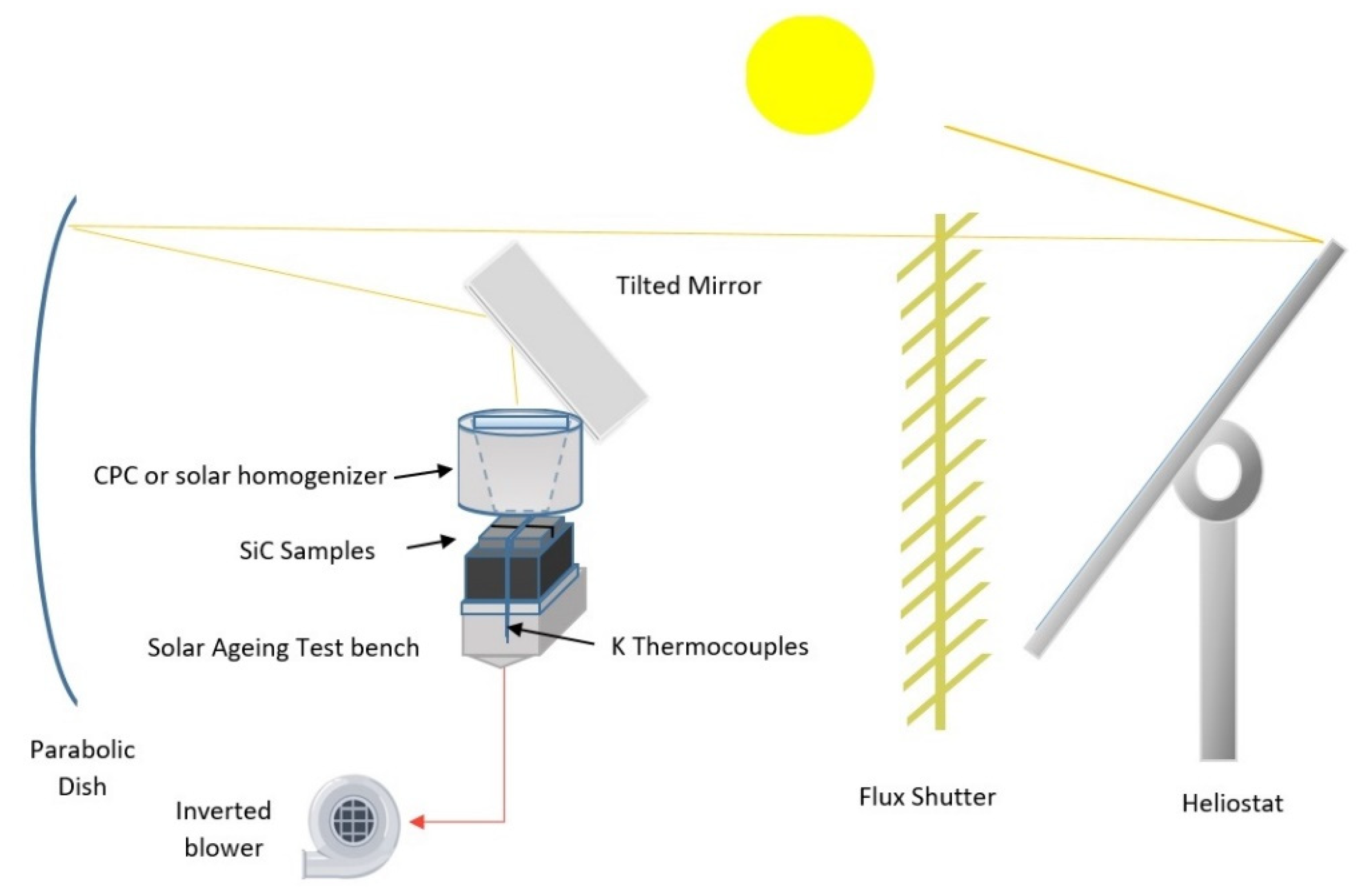
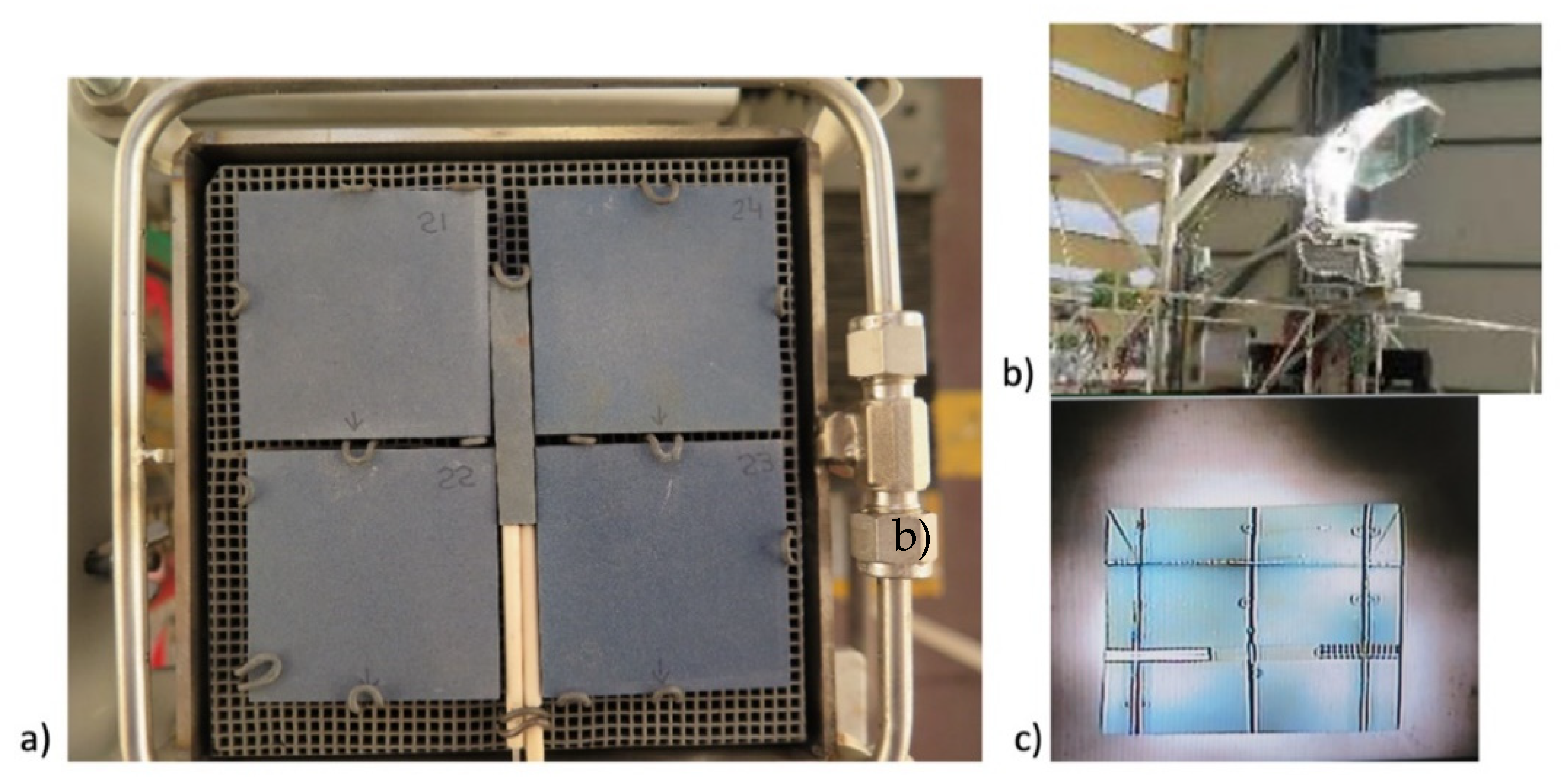


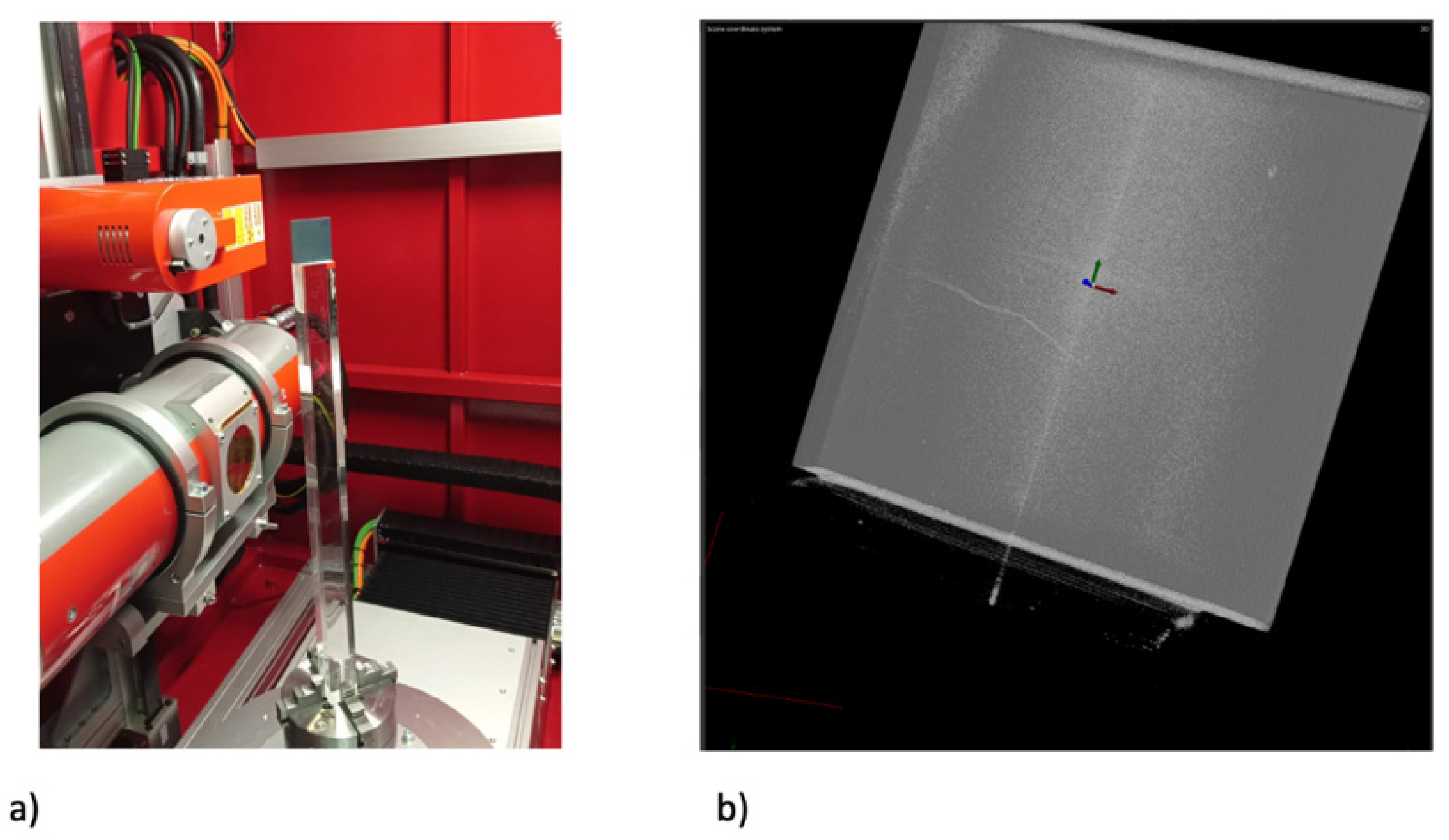
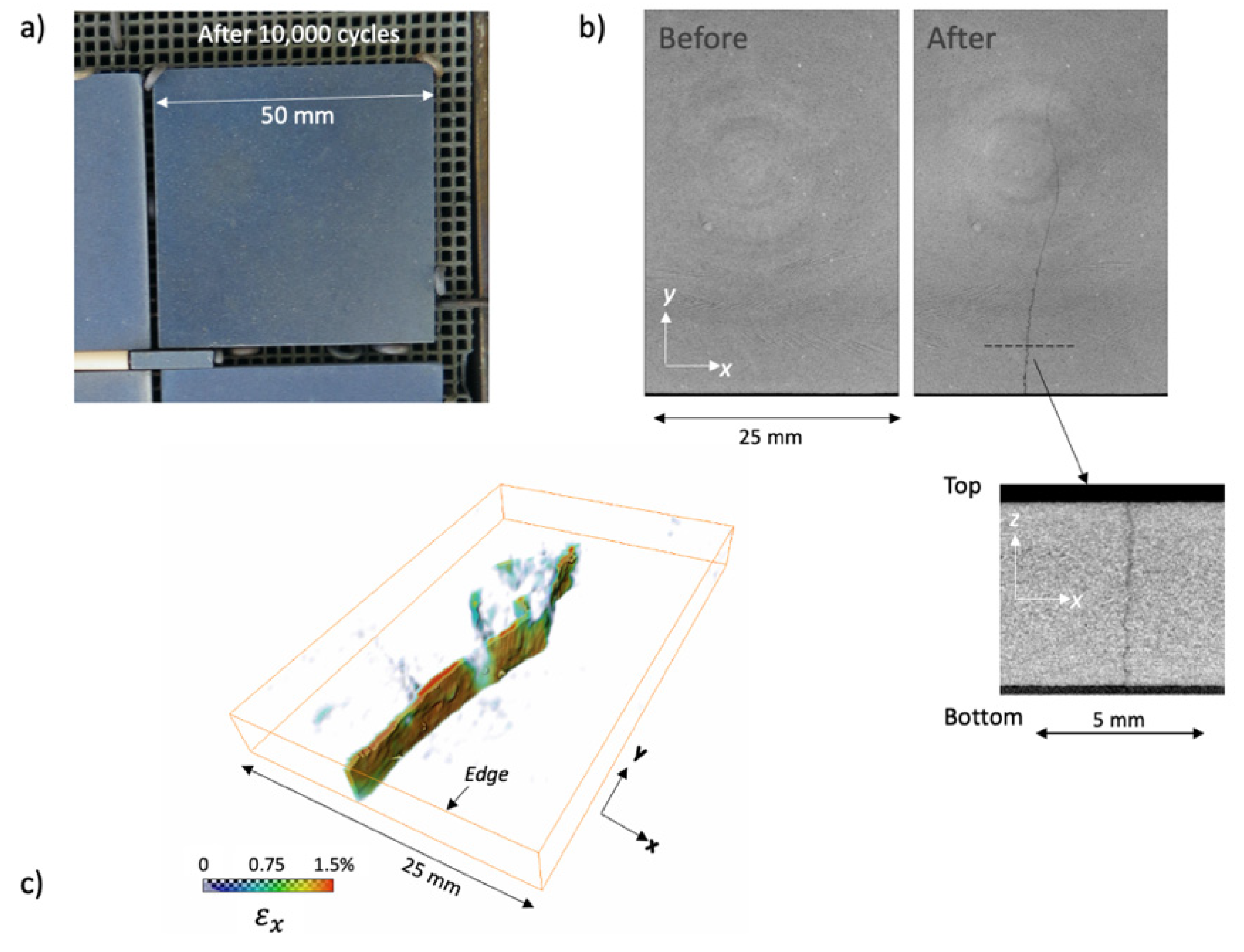
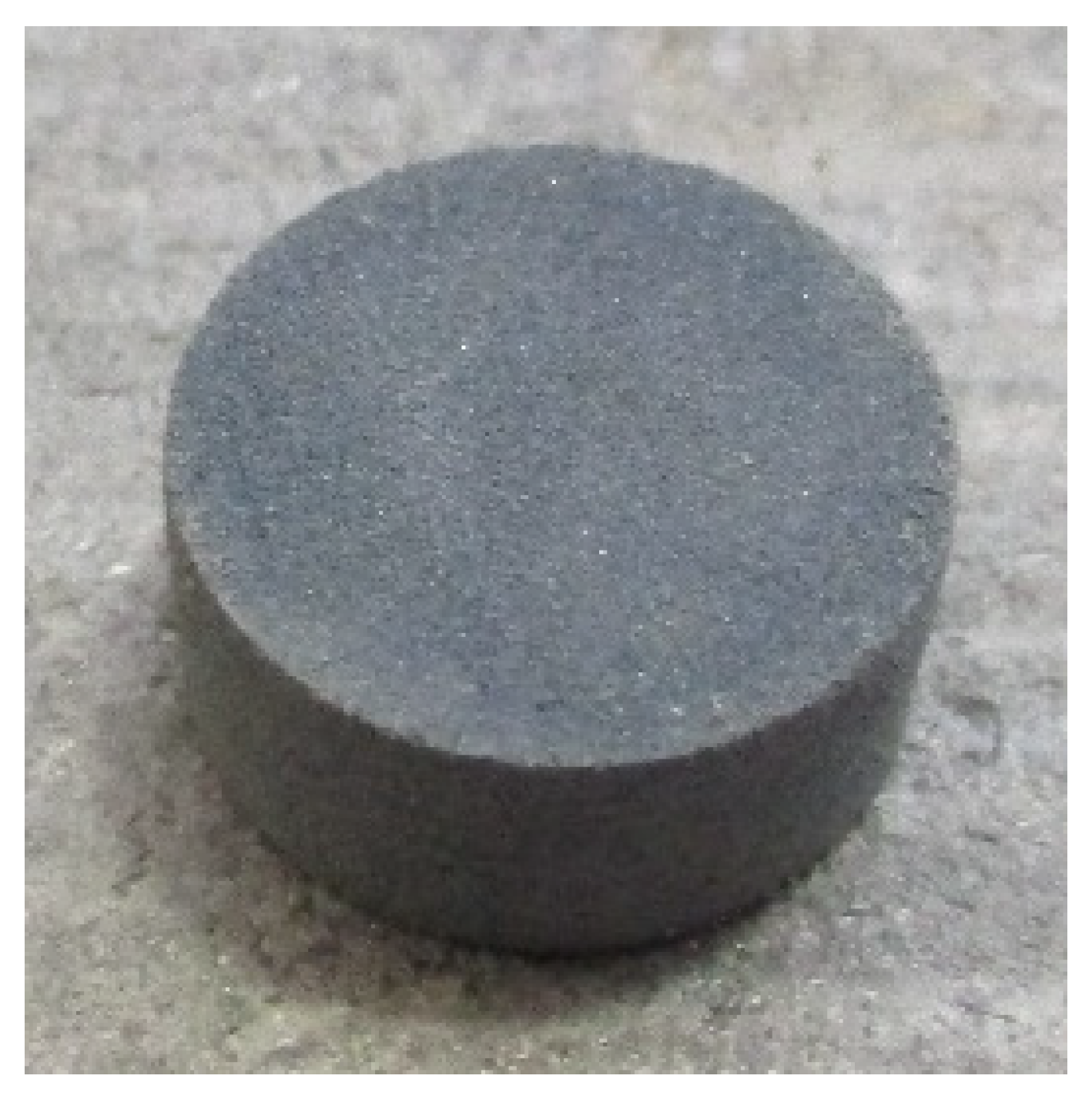
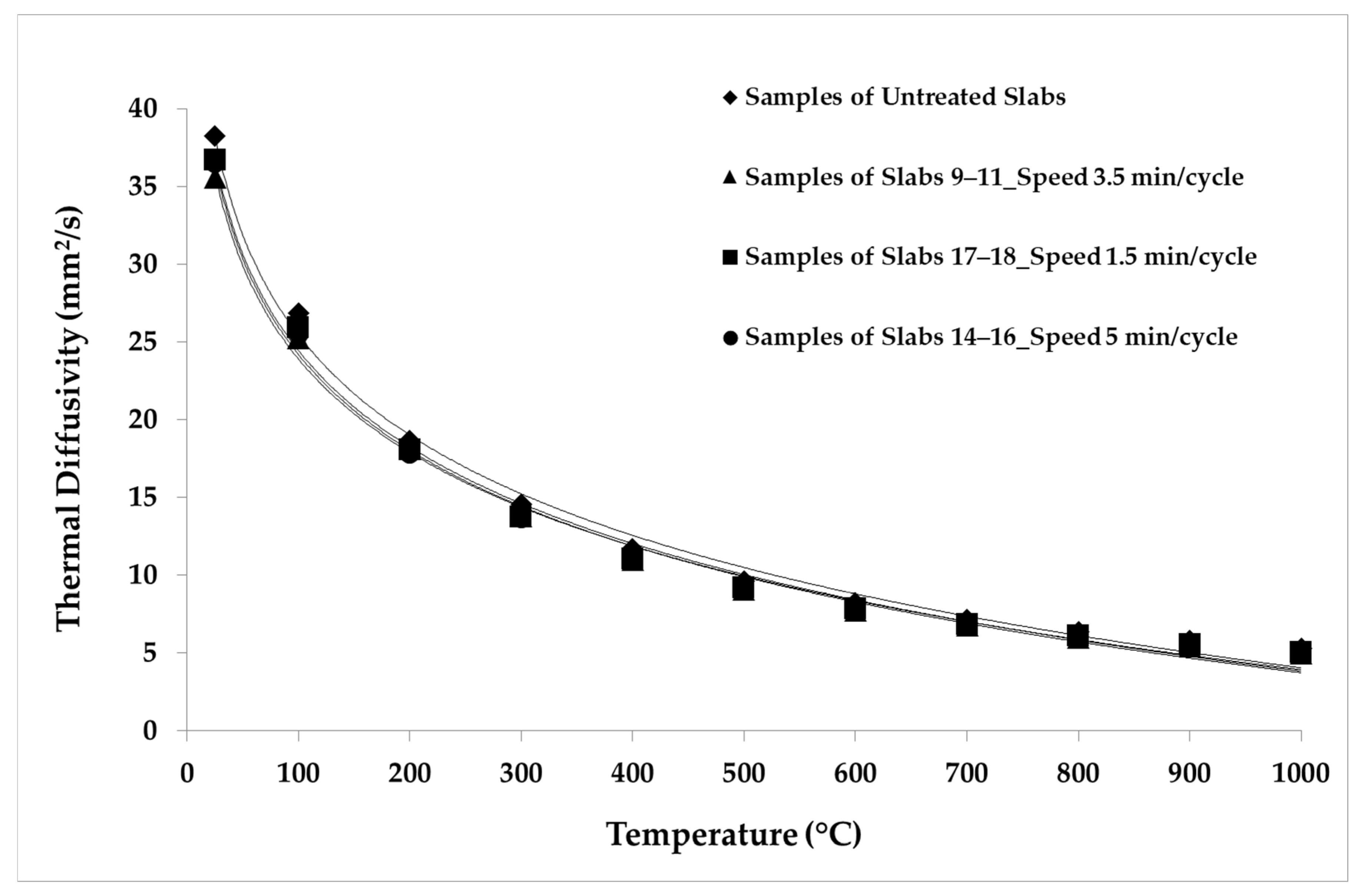
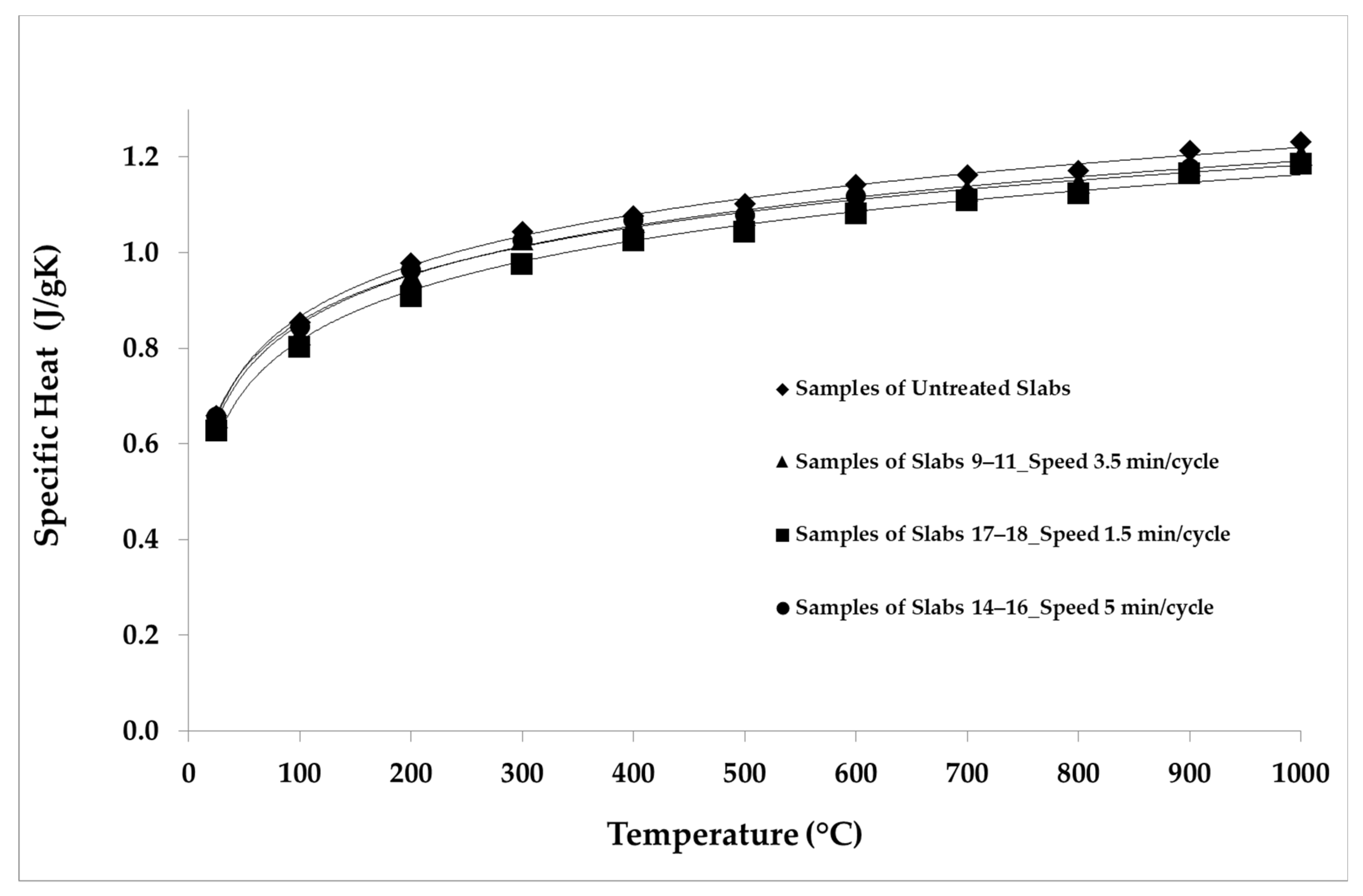

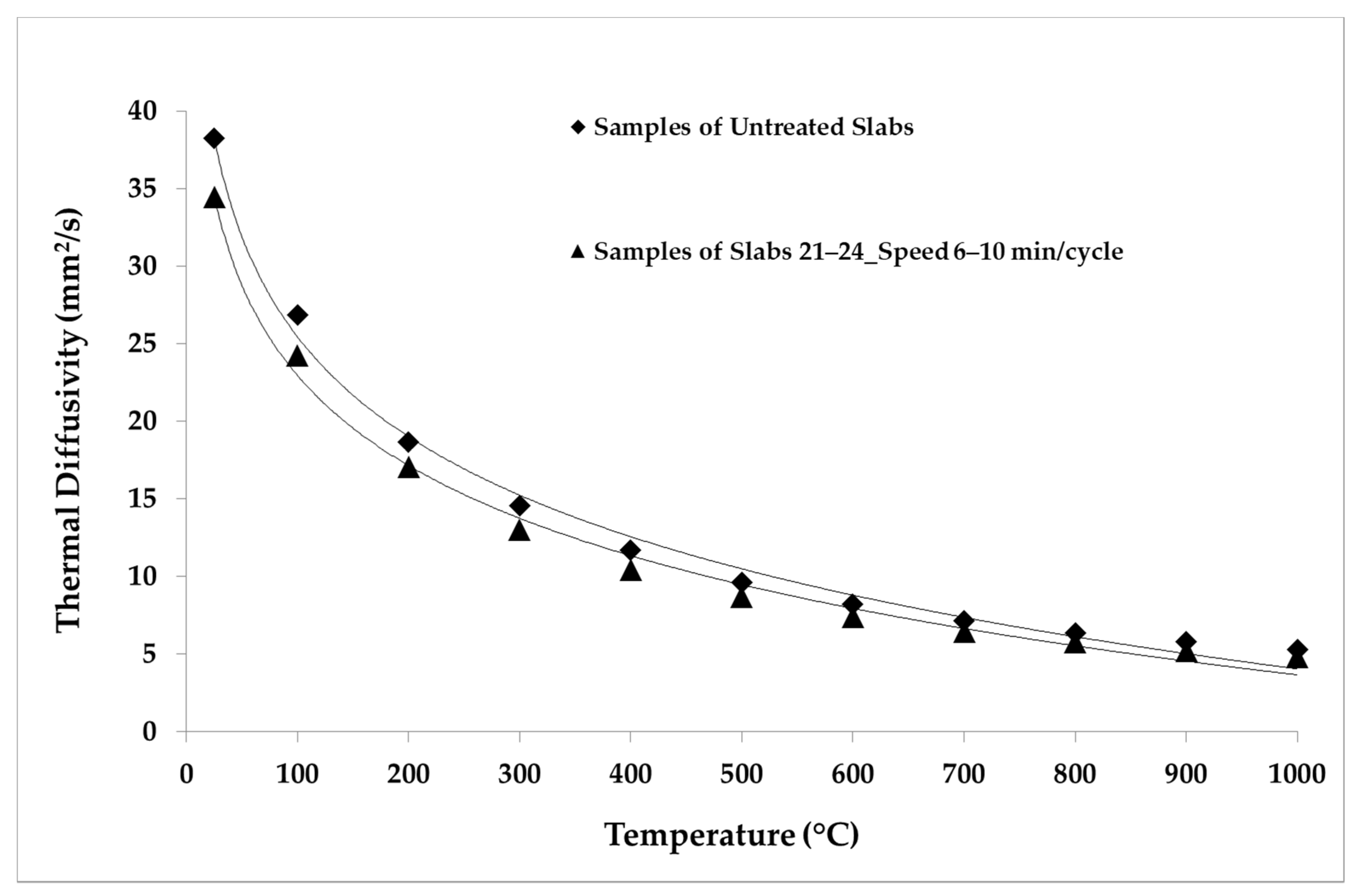
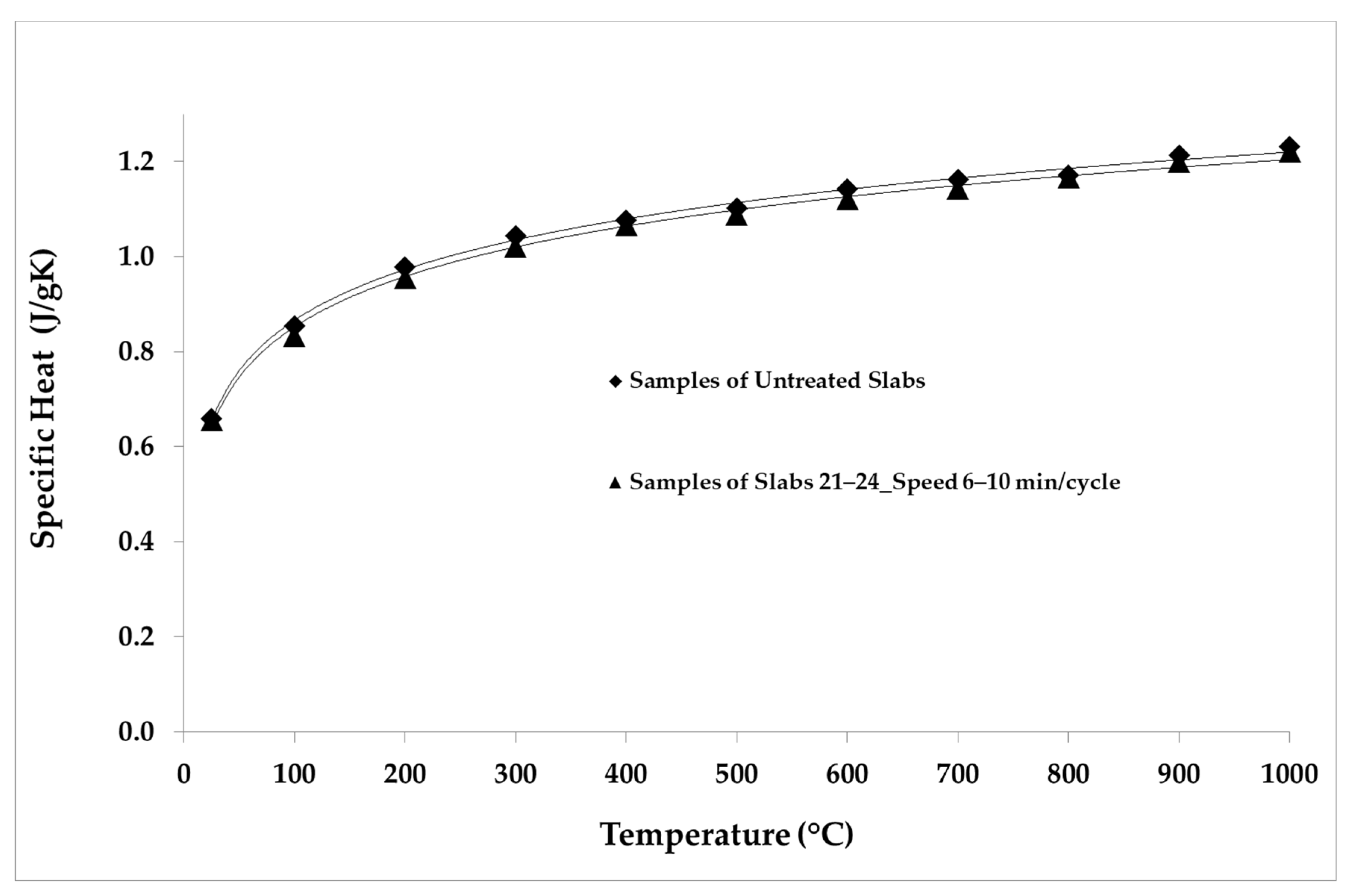

| Material or Component Tested | Project/ Receiver | Facility | Conditions | Variables Measured | Reference |
|---|---|---|---|---|---|
| RESISTIVELY HEAT LABORATORY TUBE FURNACES | |||||
| Nickel Substrates for Coatings Plated from Four Different Bath Compositions | Sandia National Laboratories DE-AC04-76-DP00789. | Resistively heat laboratory tube furnaces - Sandia | Temperature range: 350 to 450 °C aging time: 100 h–5000 h. | Optical properties: solar absorptance and emittance | Pettit, R. B. 1983 [15] |
| SiC (Laboratory Prepared Materials) | Mirasol | Resistively tubular furnace | T: 1000 °C for 0 and 600 s. Cycles: 1, 2, 5 and 10 high temperature cycles | Reflectance values | Sallaberry, F. et al., 2015 [16] |
| FRESNEL LENS | |||||
| Metallic Samples (Iron Aluminides). Silicon Oxicarbides | Mirasol | Fresnel lenses: un-mounted in CENER, and on solar tracker in CSIC-CENIM | Heating rates: - Ambient to 800 °C: 50–70 °C/s. - 800 to 1000 °C: 3–5 °C/s. Cooling rates: - 1000 to 600 °C: 9–11 °C/s. - 600–400 °C: 2–4 °C/s - 400–200 °C: 1 °C/s. | Optical and mechanical properties, such as optical and scanning electron microscopy | Sallaberry, F. et al., 2015 [16] |
| PARABOLIC DISHES | |||||
| INCONEL 625 | SFERA II | CIEMAT-PSA DISTAL | Aging temperature: 700 °C Period: up to 500 h. Samples: 5 tubular samples | Evolution of microstructure and mechanical properties: SEM, optical microscopy. Vickers hardness | Setien, E.; et al., 2017 [17] |
| SOLAR FURNACES | |||||
| SIRCON foam absorber made of SIRCON (Si3N4) | PLVCR-5 | Sandia (SNLA) Solar furnace | T average outlet air: 625 °C T max outlet air: up to 1000 °C Power: 5 kW P 10 bar Flux_max level: 2 MW/m2 | Testing in solar conditions | Pritzkow, W. 1991 [18] |
| INCONEL with Pyromak 2500 layer | PROMES-CNRS | PROMES-CNRS SAAF | Samples: 1 mm Inconel (after spray-gun application of paint coating). Mean irradiance: 104 kW/m2–173 kW/m2, 346 kW/m2 Period: 10 s, 30 s, Exposure time: 1000 s, 3000 s | Normal solar absorptance, thermal effusivity Thermal conductivity, thermal contact resistance between coating and substrate. | Boubault A., et al., 2014 [19] |
| Ceramic foams (SiC and ZrB2) as high temperature volumetric solar absorber | OPTISOL project, SFERA project, and STAGE-STE | PROMES-CNRS 6 kW solar furnace. Kaleidoscope solar flux homogenizer | Tout: 833 to 998 °C Mass flow rate: 1 g/s. α-SiC, Si-SiC, SiC, SiC + Al2O3, SiC + SiO2 + Al2O3, ZrB2. SiC range of porosity (72–92%) | Calorimetry and fluxmetry | Mey-Cloutier, S. et al., 2016 [20] |
| Mullite | STAGE-STE. SFERA II H2CORK project | CIEMAT-PSA SF40 | Tmax: average value of 1180 ± 35 °C T differences ranging - 200 °C (700–900 °C); - 400 °C (700–1100 °C) - 600 °C (700–1300 °C) | Mechanical properties: Typical strength versus strain microscopic techniques (SEM and optical microscopy). | Oliveira, F.A.C., et al., 2019 [21] |
| Group of Slabs | Number of Cycles | Inner Temperature Range (°C) | Periods (min/Cycle) | Thermal Gradient Max (°C/mm) | Tmax Surface (°C) | Flux -Normalized at 1000 W/m2 Insolation (W/cm2) |
|---|---|---|---|---|---|---|
| Slabs 17, 18, 19, 20 | 500 | 300–800 | 1.5 | ≅20–24 | 860–920 | 69–72 |
| Slabs 8, 9 10, 11 | 500 | 300–800 | 3.5 | ≅22 | 850–900 | 40–42 |
| Slabs 13, 14, 15, 16 | 500 | 300–800 | 5 | ≅10–13 | 840–880 | 42–44 |
| Slabs 21, 22, 23, 24 | 500 | 300–1000 | 6–10 | ≅10–14 | 1000–1050 | 47–55 |
| Group of Slabs | Number of Cycles | Inner T Range (°C) | Periods (min/Cycle) | Heating Rate Average Values (°C/s) | Cooling Rate Average Values (°C/s) | Max Heating Rate (°C/s) | Max Cooling Rate (°C/s) |
|---|---|---|---|---|---|---|---|
| Slabs 17, 18, 19, 20 | 500 | 300–800 | 1.5 | 22.5 | 7.0 | 50 | 30 |
| Slabs 8, 9 10, 11 | 500 | 300–800 | 3.5 | 6.5 | 3.0 | 20 | 16 |
| Slabs 13, 14, 15, 16 | 500 | 300–800 | 5.0 | 5.0 | 2.5 | 16 | 11 |
| Slabs 21, 22, 23, 24 | 500 | 300–1000 | 6.0 | 4.0 | 5.0 | 10 | 30 |
| 10.0 | 2.0 | 3.0 | 6 | 30 |
| Group of Slabs | Sample | Thickness (mm) | Density (kg/m3) |
|---|---|---|---|
| Untreated slabs | Sample from slab 1 | 5.808 | 1780 |
| Sample from slab 2 | 5.714 | 1783 | |
| Group 8–11 | Sample 1 from slab 9 | 5.648 | 1849 |
| Sample 2 from slab 11 | 6.014 | 1788 | |
| Group 13–16 | Sample 1 from slab 14 | 5.662 | 1836 |
| Sample 2 from slab 16 | 5.728 | 1809 | |
| Group 17–20 | Sample 1 from slab 17 | 5.707 | 1836 |
| Sample 2 from slab 18 | 5.674 | 1817 | |
| Group 21–24 | Sample 1 from slab 21 | 5.774 | 1777 |
| Sample 2 from slab 24 | 5.570 | 1819 |
| Temperature Range (°C) | Temperature Steps (°C) | Inert Atmosphere | Heating Rate (K/min) |
|---|---|---|---|
| 25–1000 °C | 100-(11 experimental points) | Argon | 4 |
| Temperature (°C) | Thermal Diffusivity (mm2/s) | Specific Heat (J/gK) | Thermal Conductivity (W/mK) |
|---|---|---|---|
| 25 | 38.226 | 0.660 | 44.895 |
| 100 | 26.861 | 0.854 | 40.843 |
| 200 | 18.659 | 0.979 | 32.532 |
| 300 | 14.528 | 1.044 | 26.998 |
| 400 | 11.692 | 1.077 | 22.416 |
| 500 | 9.597 | 1.103 | 18.853 |
| 600 | 8.188 | 1.142 | 16.659 |
| 700 | 7.148 | 1.162 | 14.795 |
| 800 | 6.357 | 1.173 | 13.275 |
| 900 | 5.775 | 1.214 | 12.481 |
| 1000 | 5.293 | 1.232 | 11.613 |
| Temperature (°C) | Thermal Diffusivity (mm2/s) | Specific Heat (J/gK) | Thermal Conductivity (W/mK) |
|---|---|---|---|
| 25 | 35.600 | 0.655 | 42.454 |
| 100 | 25.227 | 0.829 | 38.050 |
| 200 | 18.125 | 0.952 | 31.359 |
| 300 | 13.773 | 1.028 | 25.724 |
| 400 | 11.007 | 1.064 | 21.294 |
| 500 | 9.100 | 1.080 | 17.878 |
| 600 | 7.749 | 1.113 | 15.682 |
| 700 | 6.769 | 1.131 | 13.925 |
| 800 | 6.014 | 1.147 | 12.549 |
| 900 | 5.456 | 1.184 | 11.744 |
| 1000 | 4.993 | 1.205 | 10.944 |
| Temperature (°C) | Thermal Diffusivity (mm2/s) | Specific Heat (J/gK) | Thermal Conductivity (W/mK) |
|---|---|---|---|
| 25 | 36.478 | 0.657 | 43.605 |
| 100 | 25.476 | 0.846 | 39.191 |
| 200 | 17.809 | 0.963 | 31.239 |
| 300 | 13.663 | 1.026 | 25.508 |
| 400 | 10.913 | 1.068 | 21.240 |
| 500 | 9.036 | 1.078 | 17.746 |
| 600 | 7.703 | 1.119 | 15.707 |
| 700 | 6.719 | 1.118 | 13.690 |
| 800 | 5.967 | 1.127 | 12.258 |
| 900 | 5.407 | 1.177 | 11.592 |
| 1000 | 4.962 | 1.188 | 10.742 |
| Temperature (°C) | Thermal Diffusivity (mm2/s) | Specific Heat (J/gK) | Thermal Conductivity (W/mK) |
|---|---|---|---|
| 25 | 36.724 | 0.627 | 42.093 |
| 100 | 25.898 | 0.802 | 37.944 |
| 200 | 18.059 | 0.908 | 29.959 |
| 300 | 13.755 | 0.975 | 24.496 |
| 400 | 11.053 | 1.024 | 20.679 |
| 500 | 9.194 | 1.043 | 17.512 |
| 600 | 7.845 | 1.082 | 15.499 |
| 700 | 6.843 | 1.108 | 13.851 |
| 800 | 6.084 | 1.124 | 12.488 |
| 900 | 5.516 | 1.165 | 11.735 |
| 1000 | 5.047 | 1.186 | 10.928 |
| Temperature (°C) | Thermal Diffusivity (mm2/s) | Specific Heat (J/gK) | Thermal Conductivity (W/mK) |
|---|---|---|---|
| 25 | 34.426 | 0.656 | 40.427 |
| 100 | 24.245 | 0.833 | 36.156 |
| 200 | 17.032 | 0.956 | 29.154 |
| 300 | 13.032 | 1.021 | 23.856 |
| 400 | 10.438 | 1.066 | 19.952 |
| 500 | 8.672 | 1.088 | 16.919 |
| 600 | 7.408 | 1.121 | 14.893 |
| 700 | 6.461 | 1.143 | 13.243 |
| 800 | 5.754 | 1.166 | 12.035 |
| 900 | 5.197 | 1.199 | 11.178 |
| 1000 | 4.795 | 1.221 | 10.500 |
Publisher’s Note: MDPI stays neutral with regard to jurisdictional claims in published maps and institutional affiliations. |
© 2021 by the authors. Licensee MDPI, Basel, Switzerland. This article is an open access article distributed under the terms and conditions of the Creative Commons Attribution (CC BY) license (https://creativecommons.org/licenses/by/4.0/).
Share and Cite
Cañadas, I.; Candelario, V.M.; De Aloysio, G.; Fernández, J.; Laghi, L.; Cuesta-López, S.; Chen, Y.; Marrow, T.J.; Rinaldi, A.; Sanchez, A.M.; et al. Characterization of Solar-Aged Porous Silicon Carbide for Concentrated Solar Power Receivers. Materials 2021, 14, 4627. https://doi.org/10.3390/ma14164627
Cañadas I, Candelario VM, De Aloysio G, Fernández J, Laghi L, Cuesta-López S, Chen Y, Marrow TJ, Rinaldi A, Sanchez AM, et al. Characterization of Solar-Aged Porous Silicon Carbide for Concentrated Solar Power Receivers. Materials. 2021; 14(16):4627. https://doi.org/10.3390/ma14164627
Chicago/Turabian StyleCañadas, Inmaculada, Victor M. Candelario, Giulia De Aloysio, Jesús Fernández, Luca Laghi, Santiago Cuesta-López, Yang Chen, T. James Marrow, Antonio Rinaldi, Ana Mariblanca Sanchez, and et al. 2021. "Characterization of Solar-Aged Porous Silicon Carbide for Concentrated Solar Power Receivers" Materials 14, no. 16: 4627. https://doi.org/10.3390/ma14164627
APA StyleCañadas, I., Candelario, V. M., De Aloysio, G., Fernández, J., Laghi, L., Cuesta-López, S., Chen, Y., Marrow, T. J., Rinaldi, A., Sanchez, A. M., Tatì, A., & Testani, C. (2021). Characterization of Solar-Aged Porous Silicon Carbide for Concentrated Solar Power Receivers. Materials, 14(16), 4627. https://doi.org/10.3390/ma14164627










